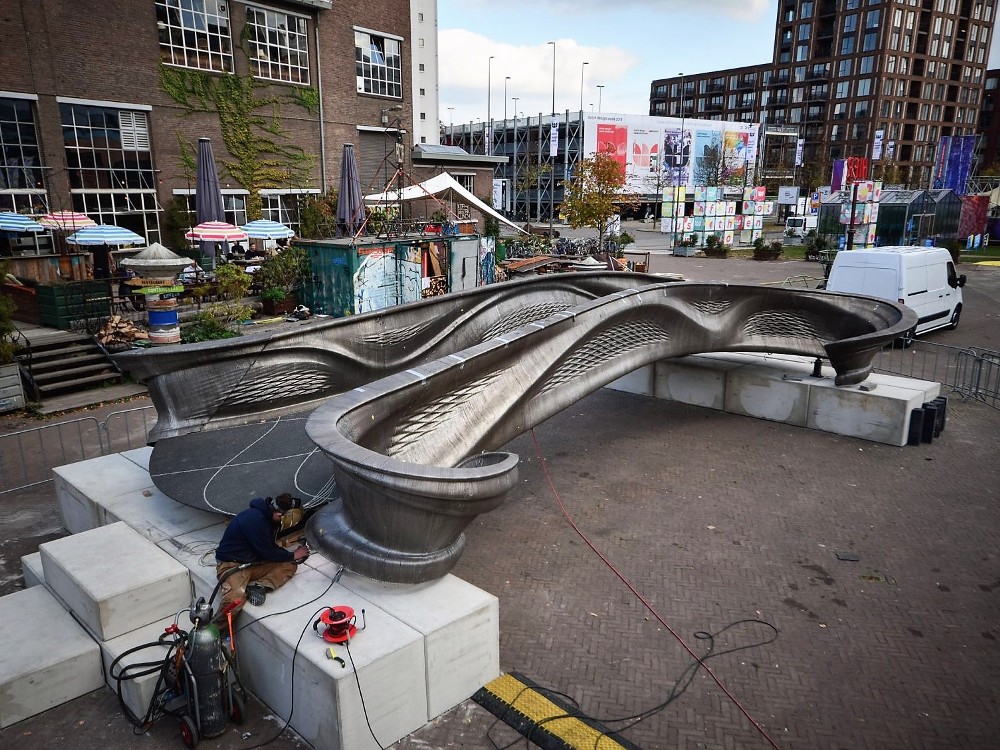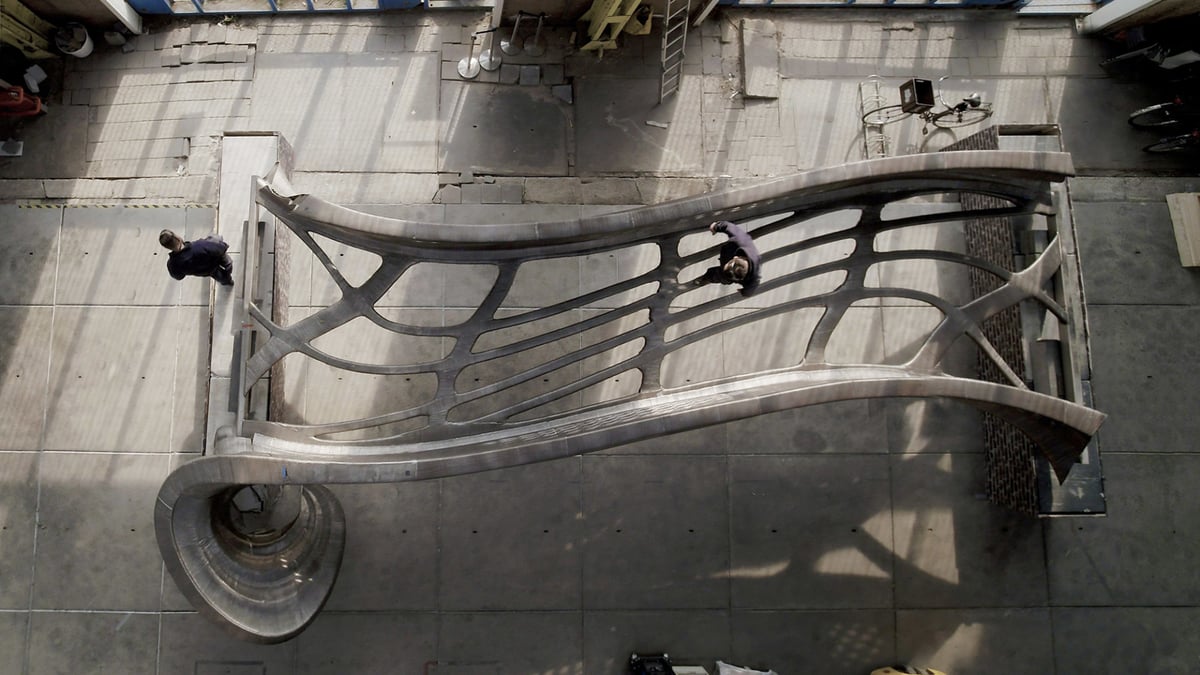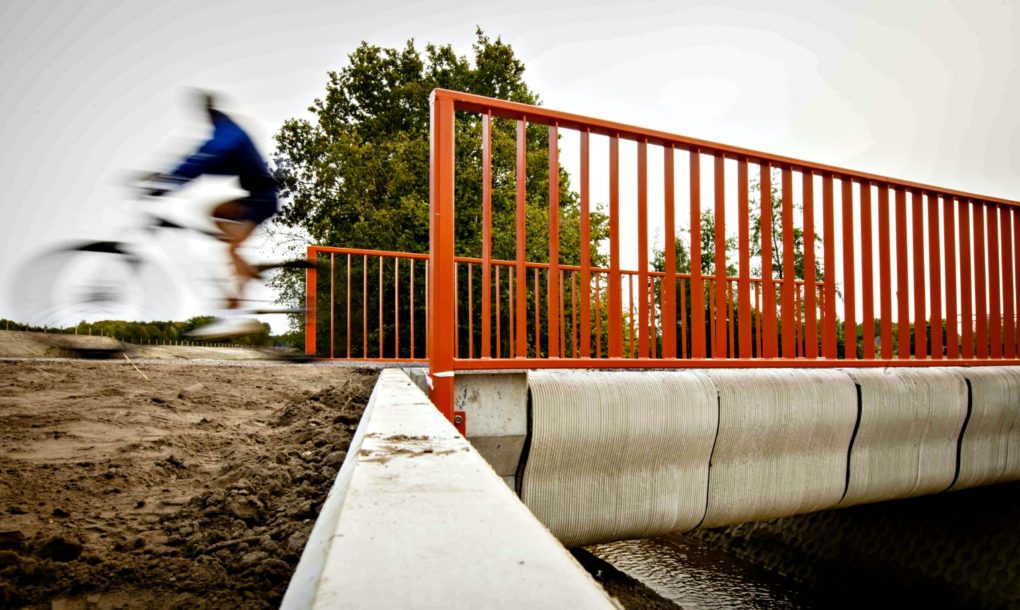Why 3D Printing Bridges?

Born alongside the idea of 3D printing concrete to make housing more affordable was the idea to 3D print bridges.
There are a few reasons why 3D printing bridges are an exciting step forward in the construction sector. Not only does 3D printing make it easier to produce interesting, exotic shapes, it also helps save material. This cuts down both on cost and build time.
In this day and age, it’s very important to be recognized. That’s why, for example, the Dutch company MX3D decided to 3D print a bridge. Not only will it help them gain experience for future projects, it also draws attention to their company. Many news sites have already written about their ambitious project of 3D printing a steel bridge. The same is true for universities, who collaborate with construction firms to create 3D printed bridges. It’s a great way to gain exposure in a never-ending race for innovation.
3D printed bridges are, as of now, either made of concrete or steel. However, it’s the details and innovation of each project that sets them apart from each other.
As of now, there are just a few 3D printed bridges around the world, but we believe the number of 3D printed structures will rise as more and more already existing projects succeed. Governments could also have a great impact encouraging projects like 3D printed bridges.
In Europe, the country that’s currently leading the way in 3D printed bridge innovation is the Netherlands.
Shanghai

At the beginning of the year, China became home to what is claimed to be the world’s largest pedestrian 3D printed bridge. It measures a stunning 26.3 m in length and 3.6 m in width
The bridge was designed by Professor Xu Weiguo from one of the country’s well-known universities, the Tsinghua University. Building it was accomplished using a concrete 3D printing system developed by the university’s team of engineers and researchers. The system consists of two robotic arms, which move around and deposit layers of concrete. In fact, the process is quite similar to FDM 3D printing.
As you’d expect, a 3D printed structure of this size must have been printed in multiple parts. The arch structure consists of 44 3D printed concrete blocks, while the bridge’s sides consist of 68 parts. The entire printing process of all the concrete parts took a grand total of 450 hours.
Sounds heavy, right? Not as much as you’d think! That’s because the parts of the bridge are hollow to save weight and material usage. However, to match the desired structural strength, reinforcing fibers were added into the concrete mix.
The main purpose of this bridge is, of course, to show off the pure potential of 3D printing in the construction sector. Thanks to 3D printing, the production of such a bridge is much cheaper since; there’s no need for steel reinforcement bars and templates, which are required with conventional concrete building techniques.
It’s estimated that this bridge would be around 30% more expensive if it was built using traditional building techniques.
The researchers who worked on this project have embedded different sensors inside the bridge for the purpose of monitoring structural vibrations and stresses. The idea is that the sensors monitor how the bridge’s structure acts under varying loads. The collected data can then be used for further developments in concrete 3D printing.
Amsterdam

Usually, it takes a good few years to design and produce complexly shaped bridges. With 3D printing, the time required to build bridges can be reduced, and the bridges themselves can be more interesting in terms of the design.
Dutch company MX3D has become famous thanks to their 3D printed bridge project. It was announced in June 2015, and the printing process started in March 2017.
That process ended in September, this year. The only thing that’s left is to perform load tests before the bridge is finally installed over one of Amsterdam’s many canals. It’s expected to go over the Oudezijds Achterburgwal in the red light district.
It took the team less than a year to produce a steel bridge. It features an incredible design that measures 12.5 meters in length and a maximum of 6.3 meters in width!
What really sets MX3D’s bridge apart is the way it was printed. It was produced by multiple robots, each of which can move in every possible direction, enabling it to 3D print in “mid-air”.
Construction went through several iterations. One of the reasons for this was to better protect the bridge against potential boat collisions.
When the bridge is finally installed, MX3D will be able to track the bridge’s health. That’s thanks to many sensors installed throughout, which collect real-time data to make sure the bridge is performing well.
Gemert, Netherlands

The world’s first 3D printed bridge comes from the Netherlands and was designed by the Eindhoven University of Technology (TU/e). It was printed using reinforced pre-stressed concrete, but the real innovation is what’s inside. The concrete 3D printer used for building the bridge integrates steel wires into the layers while printing.
The 8-meter bridge was built in multiple parts, which were joined together on-site in Gemert, where the bridge was installed. It took three months to construct, which is both faster and more material-efficient than standard methods of producing concrete bridges.
In a statement, the university had this to say: “One of the advantages of printing a bridge is that much less concrete is needed than in the conventional technique, in which a mold is filled. A printer deposits the concrete only where it is needed.”
The final result is able to support five tons, which is more than it should ever need to hold as a bridge for cyclists.
Alcobendas, Spain

Last year Spain got it’s first 3D printed bridge. It was opened on December 14th in Alcobendas, a city located in the Community of Madrid.
The project design was led by the Institue of Advanced Architecture of Catalonia (IAAC) and was executed by Acciona.
The goal for the design of this bridge was to use as little material as possible but to achieve maximum structural performance. The bridge was printed using reinforced concrete on a concrete 3D printer, and the project took a year and a half, from the concept sketch to the bridge’s installment.
Using parametric design techniques, the IAAC was able to integrate patterns taken from nature. In this way, the team was able to produce a fully functional footbridge with optimally distributed material.
The bridge measures 12 meters in length and 1.75 meters in width. It features an additional, non-3D printed fence from the inside.